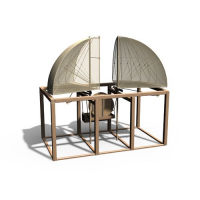
- Enlarge
- © Leonardo3 - www.leonardo3.net
Theatre stage set for Orpheus – Codex Arundel 224r and 231v 1508-18
Leonardo designed many theatre machines. This ingenious theatre stage set was devised for the staging of the myth of Orpheus for the French government in Milan during Leonardo’s second stay in the city.
It consists of a dome-shaped stage set that represented a mountain scene. Instead of being spherical, the dome could be made in many shapes with papier mâché, and painted very realistically as a mountainscape. At a precise moment in the performance, and with considerable theatrical effect, the mountains opened with a circular movement on to a new scene, the underworld, which would also reveal Pluto accompanied by devils and furies.
The mechanism was quite simple. Initially, the protagonist was in position below the stage on a small platform that worked like a lift. Behind, operators would load a container with weights. Once loaded, the container acted as a counterweight, dropping while at the same time lifting the actor up to the stage and driving the entire mechanism that opened the domes.
Renaissance staging was basically static and dominated by urban buildings set in perspective, the so-called “perspective stage setting”. Leonardo’s innovation consisted of introducing a dynamic, changing stage and setting the representation in a naturalistic, rather than an urban, space.
- Location British Library
